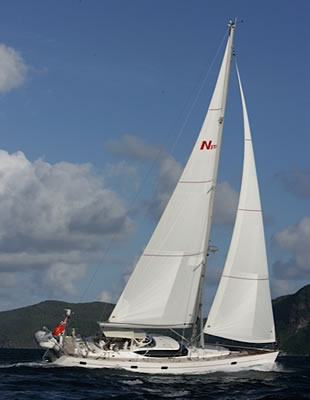The Mainsail
 |
A short vertical battened in-mast furling mainsail which can be set, reefed and struck with impunity, can give one as good a performance as any self respecting cruising sailor could wish.The battens not only provide a positive roach but avoid furling a folded leech into the mast and causing a jam.
A further advantage is found when trimming the sail, as the outhaul permits one to adjust the draft with ease, to gain maximum drive in light, moderate and strong conditions.
However, the outstanding merit is the ability to set, reef and strike the in-mast furling mainsail on any point of the wind without having to bear hard to weather to feather the sail. This can be achieved by stabilizing the main boom to leeward with the preventer and mainsheet to luff the sail just sufficiently, to furl the sail. This also averts any flogging sail or rattling boom. Another option when running dead downwind, is to centre the main boom and feather the mainsail from astern, to reef the sail in tandem with the controlled release of the outhaul.
This is particularly consoling when requiring to reef on a downwind run in deteriorating conditions, as it avoids rounding up into an ugly sea. Furthermore, as the mainsail can be reefed to suit most conditions it arguably, enables the offshore coastal cruiser to dispense with the need for a trysail.
However, I always leave half a furled roll of mainsail in the mast rather than permit the outhaul to pull the sail out to its full extremity. The reason being that if the mainsail luff should slacken, permitting the webbing at the tack to be pulled out of the mast slot and stiffen with sea water, it can prevent the sail being furled. Needless to say, this is something that would probably present itself when there was a necessity to reef with a degree of urgency!
Of all its many virtues this ability to reef the mainsail off the wind is in my opinion, the in-mast furling mainsail’s greatest attribute and far outweighs any perceived demerits i.e. increased weight aloft etc.. As most cruising yachts are now designed with in-mast furling mainsails, the naval architects have already taken such matters into accounted.